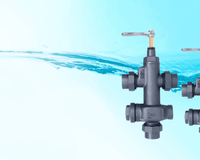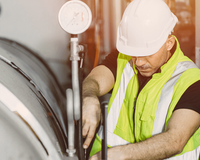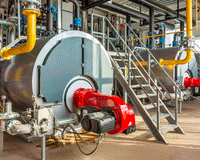Exhaust gas temperature: direct relationship with boiler efficiency
In a boiler, energy efficiency is affected by several factors, whether operational, poor quality equipment, inefficient maintenance and fuels with high humidity.
However, among the many factors, the temperature of the gases leaving the boilers (known as exhaust gases) deserves to be highlighted as it directly affects the efficiency of the equipment.
Therefore, checking the actual temperature of the exhaust gases before adjusting the boiler is an essential measure .
This temperature must be directly calculated with the value of the heat loss emitted by the chimneys, that is, any temperature value higher than the ambient temperature (origin of the gas used in combustion) will indicate heat losses.
Based on this, the “secret” is to follow the following premise: The lower the temperature of the gases, the better the energy performance, indicating lower thermal losses from the boiler.
What should be the exhaust gas temperature limit?
In practical terms, it is impossible to achieve exhaust gas temperatures equal to the ambient temperature, indicating “zero losses”.
However, we need to understand that thermal losses will always exist. It is up to the boiler regulation to allow maximum efficiency to minimize these losses and establish a temperature limit for the gases leaving the boiler.
It is also important to emphasize that the temperature of the gases cannot be lower than the condensation temperature (dew point temperature).
If the temperature of the gases is too low, condensation may occur. This process tends to form an acidic liquid, typical of boilers.
In biomass boilers, this acidic liquid is known as tar (condensation of pyroligneous acid and carbonic acid).
Tar is considered a corrosive material, which tends to damage different parts of the boiler, such as ducts, chimneys and exhaust fans, reducing the useful life of these parts and increasing maintenance costs.
Therefore, the temperature of the gases exiting through the chimney must be as close as possible to the threshold, as long as it is higher than the condensation temperature of these gases.
Measure the temperature of gases and increase the thermal efficiency of your boiler
As we have seen so far, regulation improves the boiler's energy efficiency and consequently contributes to optimizing combustion. To do this, it is necessary to correctly measure the gases that come out of the chimney.
The main gases are:
- CO2 (carbon dioxide);
- O2 (oxygen), and
- CO (carbon monoxide), which is the main indicator of low boiler efficiency.
By measuring these gases, the industry will be able to obtain the following definitions:
– Is the burning complete or incomplete?
– Is the heat released by the furnace being used well?
– Is the volume/quantity of air adequate for the combustion process?
These measurements will help define the best regulation solutions that allow for greater boiler efficiency, such as:
- Perform boiler maintenance, such as cleaning heat exchange surfaces and adjusting boiler modulation;
- Promote improvements in the thermal insulation of the equipment, aiming at retention and better use of the heat generated, preventing it from being lost through the chimney;
- Installation of gas analyzers in the chimney, if they are not part of the system;
- Improve the technical management of the boiler, mainly through the installation of energy-efficient combustion systems;
- Evaluate the possibility of using biomass with reduced humidity (and greater calorific value), among other actions.
Therefore, when measuring the gases that come out of the chimney, you will have an important factor to better regulate your boiler, resulting in increased energy efficiency.
Keep followingtheMBX Blog and see tips, recommendations and other factors related to the industrial environment.




